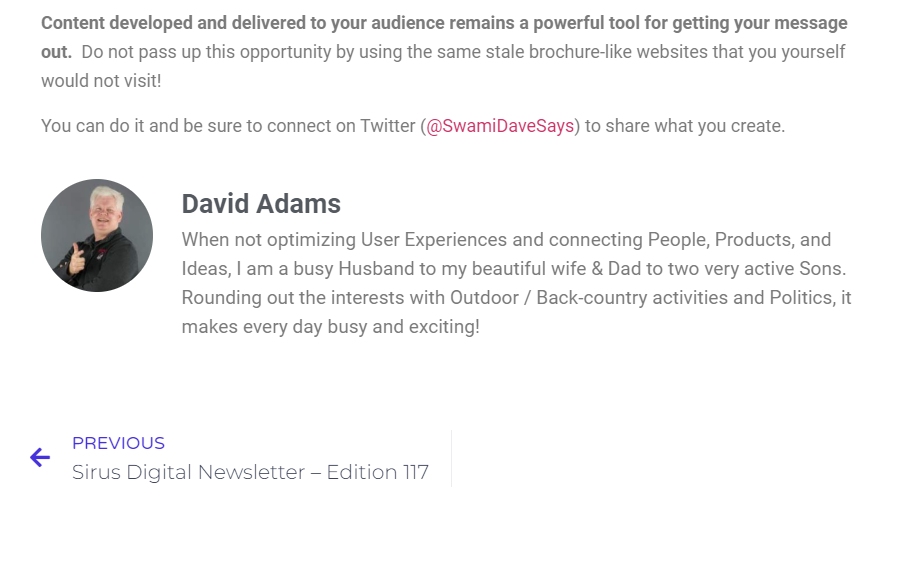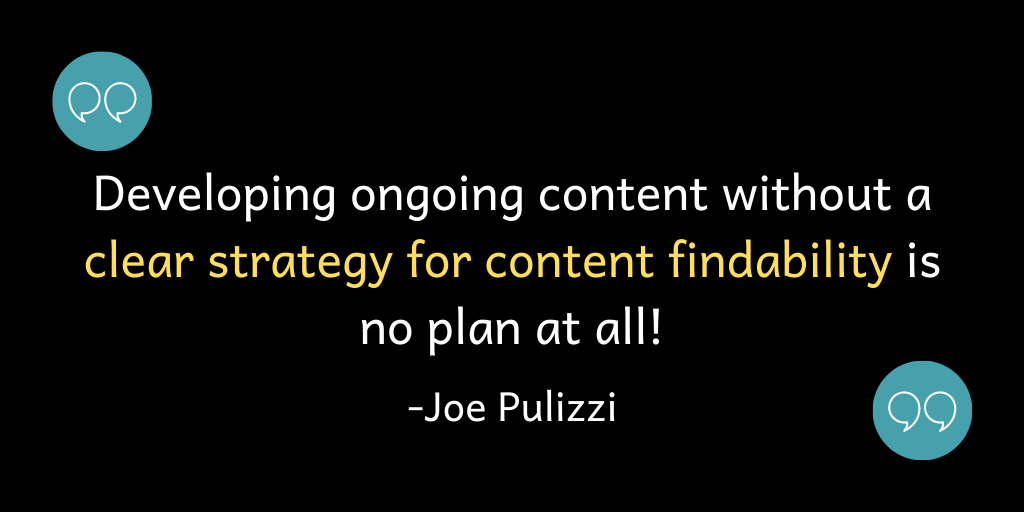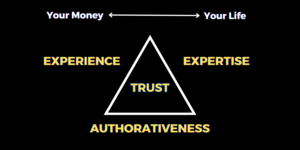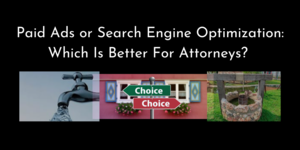With the overabundance of websites, blogs, social media, and digital advertising, getting your message heard as an Attorney serving your local community can be more complicated than ever. Writing and publishing user-focused content is one way to connect individuals needing legal representation with your law firm.
Well-written content on your website focused on the problems that your potential clients experience continues to be a cost-effective tool to get attention and client leads for a Law Office. This is especially true when planned and designed with a voice and connection to the area you serve. Look at the top ranking practices in your area on your favorite search engines (Google, Bing, etc), their websites likely contain problem-focused content (and developing your own is one way to compete).

Quick Tip:
This article shares topics related to SEO (Search Engine Optimization) and ideas for increasing your ranking in search engines (SERPs). For additional background on those topics overall, check out these additional links.
1. Picking Topics That Resonate
Topics (or Keywords/Keyphrases) are central to producing effective content for a Legal Website. These represent those questions and needs that you and your legal office are best capable of answering and satisfying.
To best identify those topics and keywords that will be most effective, be sure to understand what search engines (Google, Bing, etc.) are attempting to do and how our content can best support that objective.
Developing ongoing content without a clear strategy for content findability is no plan at all!
Joe Pulizzi, author of Content Inc. Tweet
As the algorithms used by search engines constantly change, the “ultimate search engine” does not currently exist. However, you can choose what subjects you cover and focus on those of the greatest value.
To go about selecting topics for your website, keep these things in mind.
Start with What, How, and For Whom
Honestly review your legal practice and answer the following questions. (Yes, write them down!)
- What services within your catalog does your firm provide the best counsel?
- Which cases attract your best clients and return the most revenue for your office?
- How do you and your other attorneys deliver the greatest demonstrable value to a client?
- What are the biggest questions or problems that someone would look for you to answer or solve?
By answering those four questions, you should already have a list of six-to-eight major topics that can serve as the foundation of your Keyword Strategy. You will hone them within the next two sub-sections, but this list will serve as a starting point and guide for your future themes.
Note: For this current exercise, try to stick in the six-to-eight range. Having too few can limit your options, but trying to start with too many makes it difficult to maintain focus and produce measurable results.
Focus on "Your"
Once you have an initial list of topics related to your practice’s service(s), think of ways that you might be different than someone else.
These might include (but are not limited to):
- Unique ways that problems you address might manifest in your community
- Characteristics that might change the experience of potential clients with you versus another attorney
- Local situations that might change perceptions from your audience point of view
The ultimate search engine would understand exactly what you mean and give back exactly what you want.
Larry Page, Co-Founder of Google Tweet
Because many law offices offer similar services, this exercise helps more tightly align your content with specific questions or problems most important to your best potential clients.
There is tremendous competition within SEO (and paid advertising) for easier and more generic keywords and key phrases. The more closely that you can focus your content on your target audience, the more likely they are to build an affinity with your and your practice.
Done well, it feels as if your posts are personalized to them and their situation. Whether on your site, in your office, or in the courtroom, Trust is a tremendous asset worth fostering!
Start Short; Go Long
With the original list and your additional unique characteristics, it is now time to uncover similar terms or phrases that widen your reach.
For a Bankruptcy Attorney, a topic like Debt Management can reach a similarly-interested audience that you might not attract if talking about bankruptcy alone. Likewise, engaging with more locally-focused situations or events (like the shutdown of a local manufacturer or business) could attract the attention of future clients who are not yet in a desperate financial situation.
When developing content, longer phrases or combined keywords (called “Long-Tail Keywords”) can offer less competition and more consistent results even if their overall audience reach is smaller related to more widely-used options.
To identify these extended options, here are some tools that you can use:
- AlsoAsked
- KeyworldTool.io
- Ubersuggest
- Ahrefs Keyword Generator
- Google Keyword Planner (while more focused on Paid Search Ads, this is a good tool for content development as well)
Quick Tip:
The selection of Keywords and Key Phrases is an expansive topic as it relates to Search Engine Optimization (SEO). It includes aspects of strategy, execution, analysis, and measurement. As audience interest evolves so does the value and ranking difficulty for your keyword lists.
For additional details on how to identify and manage your topics, keywords, and key phrases, check out these additional links.
2. Speak In Your Voice
Your Voice is such an important hint that it merits its own section. While the above personalization of topics focused on unique elements of your audience and your community, how you share information (tone, personality, humor, professionalism, etc) represents how you interact with your potential clients.
In this era when tools and artificial intelligence are developing a foothold in content production (and marketing overall), your voice is one of the hardest things for tools (or competitors) to duplicate. It is also one of your most valuable ways to foster an authentic relationship with your audience (and subsequently, your clients).
If you are not creating and publishing your content with your audience in mind, they cannot hear you!
David Adams, Sirus Digital Tweet
Remember that your legal website is not the only vehicle that you can use to communicate with your audience. While it is a place to share your skills, experiences, and value, it is not the only one.
Other places (both digital and not) where interested parties congregate are opportunities for you to attract and earn attention.
Do not overlook social media accounts, local community groups, and even your affiliations as contacts, audience, and possibly clients.
3. Choose Familiar Formats
As search engines evolved, audiences and their tastes naturally gravitated to a set of specific formats and patterns. Effective legal content usually takes on one of them.
They include (but are not limited to):
List Posts
List Posts are easy to recognize. They are often identifiable having a Title similar to the following pattern.
- [#] [Actions/Tips/Hints] to [Get Result]
Often, the List items are a group of actions or things that collectively produce an outcome.
An example in the legal space could be “5 Tips To Avoid Getting Sued”.
Editor’s Note: As you might have noticed, this post is an example of a List Post. 😉
Step-By-Step Guides
Step-By-Step Guides are similar to List Posts in that they “list” a set of steps to produce an intended result. A fundamental difference is an expected order that the reader would follow the steps.
For example, were you to publish a Step-By-Step Guide on selecting an attorney, the reader should identify offices that practice the specialty they need before scheduling interviews with candidates. A post like this might be Titled “X Steps To Selecting The Right Lawyer”.
If there is a natural progression of actions, you want to choose a Step-By-Step Guide post for that piece of content.
Beginner Guides
Beginner Guides are exactly as their name suggests. Audiences seek Beginner Guides to learn about new topics.
Unlike Lists or Steps, posts of this type provide background and information about the topic overall. As opposed to actions or behaviors, they are focused on elevating your audience’s knowledge.
You can recognize these types of posts by their Title which usually identifies them as a Beginner Guide for the topic (ex. “A Beginner’s Guide To Courtroom Proceedings”).
Note: When developing content of this type, be careful using jargon or industry-related terms that might be foreign to a new reader. When you do use them, be sure they are appropriately defined and explained.
You are taking the role of Teacher with an Audience who wants to learn!
Expanded Definition
Expanded Definition posts are similar in format to Beginner Guides with the exception that they delve more deeply into a specific subject or technique. Instead of providing general background and introductory information, the audience seeks more specific details to broaden and/or deepen their knowledge.
For someone who has a basic understanding of courtroom proceedings, they might want to search for a better understanding of a topic like Discovery or Appeals.
These types of content usually have a Title like “What is a Motion to Dismiss?” Someone performing this search is seeking more focused details about one part of a larger topic.
Reviews
Reviews are opportunities for you to share your experiences with your audience. These can include products, services, tools, or almost any other thing in your niche in which someone else might be interested.
This type of content can be a goldmine for building Trust and Authority within your local community. They can serve as a source of shared experience that builds affinity between you and your audience.
Google published a very good post on writing reviews. Check it out if you are creating this type of content.
4. Make It Consumable
Remember the primary goal of your content must always be answering the questions and solving the problems that your potential clients are asking. Search engines seek to link their Users to material that meets that goal as quickly as possible.
One way to accomplish this goal is to make your content as consumable as possible!
Note: Since search algorithms are designed to help find the best content for User queries, making it consumable for the search engines themselves (who index all content) is important as well.
Tags
One way to make content consumable is by formatting and presenting the information in a digestible manner.
If done well, your posts will look similar to an outline that guides your audience through the material.
- Title
- Section
- Sub-Section
- Section
To accomplish this style of organization within your post, utilize Header Tags (H1, H2, H3, etc). These elements are the technical way to format your web-published content in a consumable fashion.
For more information on using Tags to format your content, you can check out this post from HubSpot.
5. Be Succinct!
You are in the business of providing legal representation to clients!
Your content should be of the highest quality and communicate your message to your intended audience made up of clients that you wish to attract.
Do not get hung up worried about “how long” your content is or “how many words it is”. (Consider: The only reason you should be concerned is if you are getting paid by the word!)
Use direct language and the number of words that it takes for you to get across your message.
Hint: Some of the tools mentioned above in the Start Short, Go Long sub-section (Google Keyword Planner, Ahrefs, Ubersuggest) often show word counts for content similar to yours. Unless yours is vastly more detailed or intended to be more general, targeting the word count ranges of the other competing content is a good first guide.
6. Add A Bio
People trust what they see much more than what they heard (or read).
Trust is an even more powerful commodity within the legal space.
Seeing a face and background details about you (whether they read them or not) will go a long way to their perception of you and your practice.
Choose an authentic picture that represents what they will see when they meet you. Provide information about you, your practice, and your connections within the community that again promotes an affinity and introduces an actual relationship.

The usage of automation and AI is increasing at an exponential pace (even though they are almost universally despised by Users). Things that you can do to represent yourself and your legal office as real people will return massive value.
7. Link, Link, Link!
Outside of your keyword/keyphrase lists and your unique style/presentation, Links (external and internal) within your content must be a part of your overall content strategy. One style directs your audience to additional information sources outside your website; the other highlights other related content within it. Both are important to expanding your authority within your chosen areas of expertise.
External
External Links direct your audience to related information outside of your website (and your practice). No one can be all things to all people (nor should you try to be).
Identifying and highlighting other information sources shows that you are knowledgeable about the topic and what things will add value for your audience.
You know what value you bring and you know other things of value that they should see as well.
Internal
Internal Links direct your audience to other related information that they can already get on your website (and within your practice).
These are pieces of value that you have already predicted they will need and invested the resources to provide in advance.
Using Internal Links, your audience stays engaged on your website for longer periods of time which represents an important ranking factor to search engines overall.
Editor’s Note: Linking (both External and Internal) is a much deeper topic that is fundamental to your SEO efforts. As you produce content, be sure to invest the needed time and resources to ensure that you get the most benefit out of what you publish.
SEMRush has a good Beginner’s Guide on the topic that you can check out.
Wrapping It Up
Creating effective user-focused content in the legal space is not easy. Especially with tools using AI, it can feel extremely lonely trying to build a footprint for your practice among the ocean of competitors who seem to have bigger budgets and dedicated staff producing at a break-neck pace.
Do not let those feelings stop you from answering real questions asked in your local community of which you are a trusted member.
- No AI can answer (at least for now) a question for your neighbors in a way that feels like a real connection
- Few, if any, departments or staff hundreds of miles away can connect with the people in your community at the level you do.
Creating effective user-focused content in the legal space is not easy. Especially with tools using AI, it can feel extremely lonely trying to build a footprint for your practice among the ocean of competitors who seem to have bigger budgets and dedicated staff producing at a break-neck pace.
Do not let those feelings stop you from answering real questions asked in your local community of which you are a trusted member.
- No AI can answer (at least for now) a question for your neighbors in a way that feels like a real connection
- Few, if any, departments or staff hundreds of miles away can connect with the people in your community at the level you do.
Content developed and delivered to your audience remains a powerful tool for getting your message out. Do not pass up this opportunity by using the same stale brochure-like websites that you yourself would not visit!
You can do it and be sure to connect on Twitter (@SwamiDaveSays) to share what you create.



